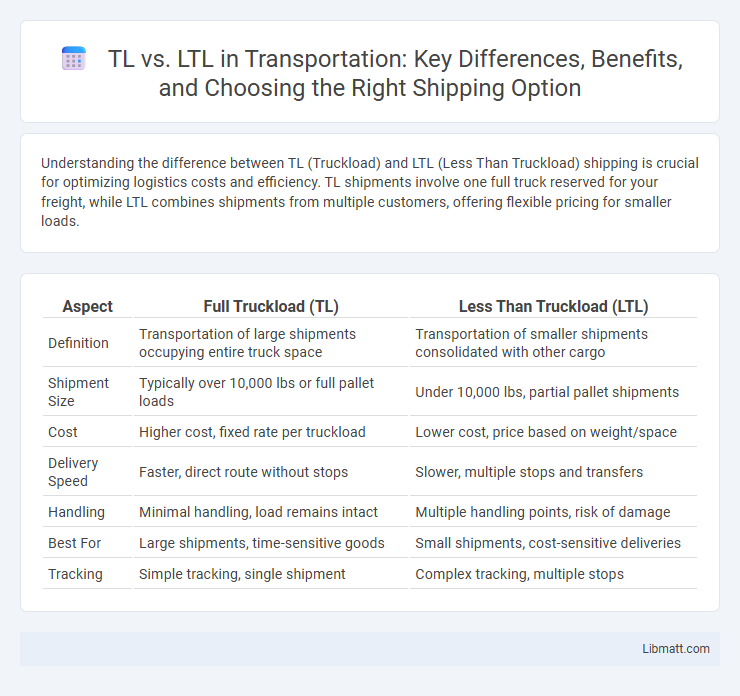Understanding the difference between TL (Truckload) and LTL (Less Than Truckload) shipping is crucial for optimizing logistics costs and efficiency. TL shipments involve one full truck reserved for your freight, while LTL combines shipments from multiple customers, offering flexible pricing for smaller loads.
Table of Comparison
| Aspect | Full Truckload (TL) | Less Than Truckload (LTL) |
|---|---|---|
| Definition | Transportation of large shipments occupying entire truck space | Transportation of smaller shipments consolidated with other cargo |
| Shipment Size | Typically over 10,000 lbs or full pallet loads | Under 10,000 lbs, partial pallet shipments |
| Cost | Higher cost, fixed rate per truckload | Lower cost, price based on weight/space |
| Delivery Speed | Faster, direct route without stops | Slower, multiple stops and transfers |
| Handling | Minimal handling, load remains intact | Multiple handling points, risk of damage |
| Best For | Large shipments, time-sensitive goods | Small shipments, cost-sensitive deliveries |
| Tracking | Simple tracking, single shipment | Complex tracking, multiple stops |
Understanding TL (Truckload) and LTL (Less Than Truckload) Shipping
TL (Truckload) shipping involves transporting large shipments that fill an entire trailer, offering direct routes and faster delivery times due to minimal handling. LTL (Less Than Truckload) shipping combines multiple smaller shipments from various customers into one trailer, optimizing cost efficiency and ideal for businesses with smaller loads. Choosing between TL and LTL depends on shipment size, delivery speed requirements, and budget considerations.
Key Differences Between TL and LTL Freight
TL (Truckload) freight involves shipping large volumes that fill an entire trailer, providing direct and exclusive use of the truck, ideal for businesses shipping bulk goods or heavy loads. LTL (Less Than Truckload) freight consolidates shipments from multiple customers in one trailer, optimizing cost-efficiency for smaller shipments that do not require a full truck. Key differences include shipment size, cost structure, transit time, and handling frequency, with TL offering faster delivery and reduced handling compared to LTL's pooled shipments and multiple stops.
Advantages of Using Truckload (TL) Shipping
Truckload (TL) shipping offers significant advantages including cost-efficiency for large, dense shipments due to direct routing from origin to destination. TL shipping minimizes handling, reducing the risk of damage and transit delays compared to Less Than Truckload (LTL) freight, which involves multiple stops and transfers. With TL, shippers gain greater control over scheduling and faster transit times, improving supply chain reliability for time-sensitive cargo.
Benefits of Less Than Truckload (LTL) Shipping
Less Than Truckload (LTL) shipping offers significant cost savings by allowing multiple shippers to share space on the same trailer, reducing your freight expenses compared to full Truckload (TL) shipments. LTL shipping also provides enhanced flexibility with more frequent pickup schedules and a wider range of delivery options, ideal for smaller shipments that don't require an entire truck. Furthermore, LTL carriers often include built-in tracking services and reduce the risk of damage since freight is handled less frequently than in TL shipments.
Cost Comparison: TL vs LTL
Full Truckload (TL) shipping generally costs more upfront than Less Than Truckload (LTL) due to the exclusive use of the entire trailer space, which reduces handling and transit times. LTL freight is typically more cost-effective for smaller shipments as it consolidates multiple shippers' goods into one load, sharing expenses across multiple customers. However, TL can provide better value when shipping large volumes or time-sensitive deliveries by minimizing potential delays and handling fees associated with LTL services.
When to Choose TL for Your Shipments
Choose TL (Truckload) shipping when your shipment requires the entire trailer capacity or when transporting large, heavy, or high-volume goods directly from origin to destination. TL is ideal for reducing handling, minimizing damage risks, and optimizing delivery speed for full truckload shipments. Businesses shipping time-sensitive or bulk products benefit from the dedicated and faster transit times that TL provides compared to LTL (Less Than Truckload).
When LTL Shipping is the Better Option
LTL shipping is the better option when businesses need to transport freight that doesn't require a full truckload, typically ranging from 150 to 15,000 pounds. It offers cost efficiency by allowing multiple shippers to share space on one truck, reducing expenses compared to TL shipping. LTL is ideal for small to medium-sized shipments with flexible delivery times and when minimizing inventory holding costs is a priority.
Factors Affecting TL and LTL Shipping Rates
TL (Truckload) and LTL (Less Than Truckload) shipping rates are influenced by factors such as shipment size, distance, weight, and freight class. TL rates typically benefit from economies of scale when transporting full truckloads, while LTL pricing depends heavily on the consolidation of multiple smaller shipments and handling requirements. Market demand, fuel costs, and carrier capacity also play crucial roles in determining the cost differences between TL and LTL shipping options.
Common Industries Using TL and LTL Services
TL (Truckload) services are predominantly used in industries such as automotive, manufacturing, and retail that require full truck capacity for large shipments. LTL (Less Than Truckload) services are favored by small to medium-sized businesses in industries like electronics, pharmaceuticals, and consumer goods due to their ability to consolidate multiple smaller shipments. Both TL and LTL play crucial roles in logistics operations for industries including food and beverage, e-commerce, and industrial equipment.
How to Optimize Your Freight Strategy: TL vs LTL
Choosing between TL (Truckload) and LTL (Less Than Truckload) depends on shipment size, cost-efficiency, and delivery speed. TL offers full-truck capacity ideal for large shipments, reducing handling time and minimizing damage risk, while LTL suits smaller loads by sharing space and costs among multiple shippers. An optimized freight strategy leverages TL for bulk goods requiring direct transit and LTL for flexible, cost-effective smaller shipments with consolidated routes.
TL vs LTL Infographic

 libmatt.com
libmatt.com